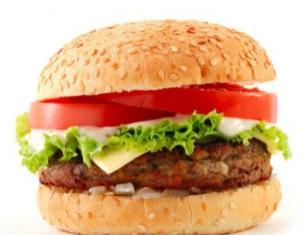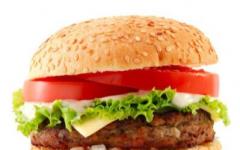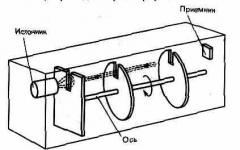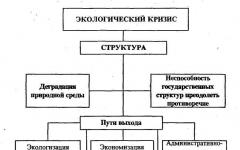M. Yu.Demidova,
, FIPI, Moscow;
E. E. Kamzeeva,
FIPI, Moscow
On the use of the results of the GIA of basic school graduates in a new form in 2008 in teaching physics
Demonstration version-2008
Part 3
23. Using a carriage (block) with a hook, a dynamometer, one weight, a guide rail, assemble an experimental setup to determine the sliding friction coefficient between the carriage and the rail surface.
In the answer sheet: 1) draw a drawing of the experimental setup; 2) write down the formula for calculating the coefficient of sliding friction; 3) indicate the results of measuring the weight of the carriage with a load and the sliding friction force when the carriage moves along the surface of the rail; 4) write down the numerical value of the sliding friction coefficient.
Correct answer: __________________
Evaluation criterion for 4 points
Completely correct performance of the task, including: 1) schematic drawing of the experimental setup; 2) the formula for calculating the desired value for the quantities available for measurement (in this case - for the coefficient of sliding friction through the weight of the carriage with a load and the sliding friction force - the traction force); 3) correctly recorded results of direct measurements (in this case - the results of measuring the weight of the carriage with a load and the sliding friction force - traction force); 4) the obtained correct numerical value of the desired value.
Equipment characteristics
When performing the task, a set of equipment No. 4 is used, consisting of: a carriage with a mass of (100 ± 2) g; cargo weighing (100 ± 2) g; school dynamometer with a measurement limit of 4 N (error 0.1 N); guide rail.
Attention! When replacing any piece of equipment with a similar one with other characteristics, it is necessary to make the appropriate changes to the sample of the task.
Sample of possible execution
1) Schematic of the experimental setup:
2) F thrust = F tr (with uniform movement); F tr = μ N; N = P → F tr = μ P → μ = F thrust / P.
3) F thrust = 0.4 N; P= 2.0 N;
Guidance to experts
1. The estimate of the boundaries of the interval, within which the correct result obtained by the student may turn out to be, is calculated by the method of boundaries. Taking into account the measurement error of the dynamometer, we get: F thrust = 0.4 ± 0.1 N; P= 2.0 ± 0.1 N. Since μ = F thrust / P, then the lower limit of the sliding friction coefficient NG (μ) = 0.3 N / 2.1 N = 0.14; upper limit of VH (μ) = 0.5 N / 1.9 N = 0.26.
2. Please note that the results of measuring the sliding friction force (traction force) will depend on the material and surface finish of the table.
24. Two spirals of an electric stove with a resistance of 10 ohms each are connected in series and connected to a network with a voltage of 220 V. Water weighing 1 kg, poured into an aluminum pan weighing 300 g, boiled after 148 s. What is the starting temperature of the water and the pot? Disregard the energy losses for heating the ambient air.
Correct answer: ____________
A complete correct solution is given, including the following elements: 1) a short statement of the problem is correctly written; equations and formulas are written, the application of which is necessary and sufficient for solving the problem by the chosen method (in this solution - energy conservation law, Joule-Lenz law, formulas for calculating the amount of heat received by water and a saucepan when heated, the resistance of resistors when they are connected in series
Sample Potential Solution
25. The car starts off and, moving at uniform acceleration, picks up speed of 36 km / h in 20 seconds. What is the mass of a car if it is known that the work done by its engine is 2 · 10 5 J, and the average resistance force acting on the car is 400 N?
Correct answer: ________________
Evaluation criterion for 3 points
A complete correct solution is given, including the following elements: 1) a short statement of the problem is correctly written; 2) equations and formulas are written, the application of which is necessary and sufficient for solving the problem by the chosen method (in this solution - work formula, Newton's second law, equations of velocity and displacement at uniformly accelerated motion ); 3) the necessary mathematical transformations and calculations are performed, leading to the correct numerical answer, and the answer is presented. In this case, a solution is allowed "in parts" (with intermediate calculations).
Sample Potential Solution
26. What burns the skin more strongly: water or water vapor at the same temperature? Explain the answer.
Correct answer: ________________
Evaluation criterion for 2 points
The correct answer is presented, a sufficient justification is provided without errors.
Sample possible answer
1. Water vapor burns more.
2. The surface of the skin in short-term contact with water receives energy only due to the cooling of a thin layer of water in the contact zone. If steam gets on the skin, then energy is released both during the condensation of steam and when the water formed on the skin is cooled. And although the mass of the formed water may be small, the condensation process is accompanied by the release of a large number heat, which causes a more severe burn.
Evaluation criteria for the task 23 by 3, 2, 1 and 0 points; tasks 24 and 25 for 2, 1 and 0 points; assignments 26 for 1 and 0 points, see No. 1/09. - Ed.
Boiling
Every day we observe how water and its vapor pass into each other. Puddles on the asphalt dry up after rain, and water vapor in the air in the morning often turns into the smallest droplets of fog.
What happens if a vessel with a certain volume of liquid is closed with a lid? Every second, the fastest molecules will still leave the surface of the liquid, its mass will decrease, and the concentration of vapor molecules will increase. At the same time, part of its molecules will return to the liquid from the vapor, and the higher the vapor concentration, the more intense the condensation process will be. Finally, a state will come when the number of molecules returning to the liquid per unit of time will, on average, become equal to the number of molecules leaving it during this time. This state is called dynamic equilibrium, and the corresponding pair is saturated steam.
The saturated vapor pressure depends on the type of liquid and temperature. The harder it is to tear the molecules of a liquid from each other, the lower the pressure of its saturated vapor will be. The dependence of the saturated water vapor pressure on temperature is shown in the figure.
Dependence of saturated water vapor pressure on temperature
Boiling is the process of formation of a large number of vapor bubbles that occurs throughout the volume of the liquid and on its surface when heated. In fact, these bubbles are always present in the liquid, but their size grows, and they become noticeable only when boiling. The bubbles expand and, under the action of the buoyancy force of Archimedes, break away from the bottom, float up and burst on the surface.
Boiling begins at a temperature when gas bubbles have the opportunity to expand, and this happens if the saturated vapor pressure rises to atmospheric pressure. Thus, the boiling point is the temperature at which the saturated vapor pressure of a given liquid is equal to atmospheric pressure (pressure above the surface of the liquid).
The pressure cooker has a safety valve that opens at a pressure of 1.4 ∙ 10 5 Pa. Boiling point of water in a pressure cooker
| Answer: | 2? |
When completing task 22 with a detailed answer, use a separate sheet. Write down the task number first, and then the answer to it. A complete answer should include not only the answer to the question, but also its detailed, logically coherent rationale. Write down your answer clearly and legibly.
Is it possible to observe the process of bubble boiling of water on space station in zero gravity? Explain the answer.
It is possible, since body weight does not affect the boiling of water. It is influenced by atmospheric pressure. The boiling process is much slower on the space station than on Earth, but it does.
Part 2
Use a separate sheet for answers to tasks 23–26. First write down the task number (23, 24, etc.), and then the answer to it. Write down the answers clearly and legibly.
Using a tripod with a clutch and a foot, a weight with a string attached to it, a meter ruler and a stopwatch, assemble an experimental setup for studying the free vibrations of a string pendulum. Determine the time of 30 full oscillations and calculate the oscillation frequency for the case when the length of the thread is 50 cm.
In the answer form:
1) draw a drawing of the experimental setup;
2) write down the formula for calculating the vibration frequency;
3) indicate the results of direct measurements of the number of oscillations and the time of oscillations;
4) write down the numerical value of the oscillation frequency of the pendulum.
Task 24 is a question to which you must give a written answer. A complete answer should contain not only the answer to the question, but also its detailed, logically coherent rationale.
What burns the skin more strongly: water or water vapor of the same mass at the same temperature? Explain the answer.
Water vapor burns the skin more strongly, since the internal energy of the steam is greater than the internal energy of water, therefore, when the steam comes into contact with the skin, more energy is released than that of hot water, a burn is formed.
For tasks 25-26, it is necessary to write down the complete solution, including the record of a short condition of the problem (Given), the record of formulas, the use of which is necessary and sufficient to solve the problem, as well as mathematical transformations and calculations leading to a numerical answer.
The potential energy of a bullet fired from the barrel vertically upwards, 4 s after the start of movement, is 40 J. What is the mass of a bullet if its initial velocity is 40? Potential energy bullets count from the start level.
An electric heater brings 2.2 kg of water to a boil in 20 minutes, the initial temperature of which is 10 ° C. The current in the heater is 7 A, the efficiency of the heater is 45%. What is the voltage in the electrical network?
Burns are injuries to the skin and tissues, which most often occur due to the action of high temperature: leaning against hot water, spilling boiling water on the skin.
But a burn can be earned in other ways. Dangerous:
- Radiation. Therefore, we either suffer from an overdose of the tanning bed.
- Chemical substances. Therefore, household chemicals must be removed to a safe place and work with them in protective clothing: gloves, an apron and glasses.
- Friction. Therefore, you must carefully descend the tightrope.
- Electricity. Therefore, electrical injuries are so dangerous: they affect tissues with deep burns.
What to do if you get burned
Whatever the burn, you must act in the same way.
1. Stop the burn
In first aid textbooks, this is called “terminating the damaging agent”. This means that you need to get a person out from under a stream of boiling water or from an acid puddle, for example, as soon as possible. It seems obvious, but in a moment of panic, anything can happen.
If you are helping someone, make sure you are safe first. That is, make sure that you yourself do not get under the boiling water and do not get into a puddle of acid.
2. Call a doctor if necessary
Be sure to call the ambulance or ambulance if:
- The injury was due to electric shock.
- Chemical burn.
- A burn of the third degree or more, that is, when the skin becomes covered with blisters, when they merge into one large, when the skin in the burn area is brown or black, dry and insensitive.
- Burns of any degree more than 10% of the body surface. To roughly determine how much it is, be guided by the size of the victim's palm. One palm - approximately 1% of the body area.
- A child or a person over 70 years of age was burned.
If the burn is light, but more than five centimeters in diameter, you do not need to call an ambulance. And yet it is necessary to get to the emergency room. And be sure to show your doctor if burns are on your face or genitals.
3. Cool the burn
Submit the affected area under cool running water for about 15–20 minutes. The water should not be icy.
4. Apply a dry, clean bandage to the burn
It is best if the dressing is sterile. The size is needed so that the bandage or gauze completely covers the burn. Do not apply the bandage too tightly.
5. Give pain reliever
Any pill based on paracetamol, ibuprofen or nimesulide will help the victim.
6. Give drink
The victim needs to drink as much as possible, because burns, even small ones, reduce the volume of circulating blood. You need to drink something warm and sweet: tea, compote.
What not to do
You should definitely not apply ointment to the affected area.
Moreover, you cannot use eggs, butter, sour cream and all other means: they will only slow down healing and interfere with doctors who will begin to treat the wound. In addition, bacteria can enter the wound with sour cream or oil.
Even if these methods have worked for ten generations of your grandmothers and great-grandmothers, don't do it. Leave the wound clean.
Can't wait to treat - treat with chlorhexidine if the burn is shallow.
Also, do not apply ice to the surface of the wound, so as not to injure it also by cold when the skin is already damaged.
When you can do without a doctor
Minor domestic injuries can be treated on their own. Small - this is when there is only redness or a few blisters from a burn, and the affected area is not more than five centimeters in diameter.
In this case, you need to take anesthetic, drink a lot and treat the burn with a special spray with dexpanthenol. This substance helps quick healing, and in the form of a spray it is convenient to apply to painful burns.
Where will the cream on milk settle faster: in a warm room or in the refrigerator? Why?
What burns the skin more strongly: water or water vapor at the same temperature and mass? Explain the answer.
What kind of spot (dark or light) at night on an unlit road does a puddle appear to a pedestrian in the headlights of an approaching car? Explain the answer.
Two lenses were cut from a thin plane-parallel plate: convex and concave (see figure). Compare the optical power of lenses by modulus. Explain the answer.
5. The boat floats in a small pool. How the water level in the pool will change if you carefully lower it from the boat into the pool big Stone? Explain the answer.
6.How does ice skating change with increasing frost? Explain the answer.
7. Two students simultaneously measured atmospheric pressure using a barometer: one, while in the schoolyard under open air the other is in the physics classroom on the fifth floor. Will the barometer readings be the same? If not, which barometer will show the higher barometric pressure? Explain the answer.
8.A drop of oily liquid falls on the surface of the water and spreads, forming a thin film, Will this film necessarily cover the entire surface of the water? Explain the answer.
9.Can screens in cinemas be mirrored? Explain the answer.
10. A piece of ice floats in a glass of water. How will the water level in the glass change as the ice melts? Explain the answer.
11. The stone lies at the bottom of the vessel, completely submerged in water. How will the force of pressure of the stone to the bottom change if table salt is added to the water? Explain the answer.
12. An electrical circuit is fixed on a vertically located board (see figure), consisting of a current source, a lamp, an elastic steel plate AB. A weight was suspended from one end of the plate, causing the plate to bend and open the circuit. What will happen in the electrical circuit when the board starts to fall freely? Explain the answer.
 13 . Two identical brass balls fall from the same height. The first ball fell into the sand and stopped, and the second, hitting a stone, bounced and was caught by the hand at a certain height. The internal energy of which ball has changed by a large amount? Explain the answer.
13 . Two identical brass balls fall from the same height. The first ball fell into the sand and stopped, and the second, hitting a stone, bounced and was caught by the hand at a certain height. The internal energy of which ball has changed by a large amount? Explain the answer.
14. Which car - a truck or a car - should have stronger brakes? Explain the answer.
15. When will less fuel be needed: when launching an artificial satellite from the Earth or from the Moon? Explain the answer.
Solving quality problems
EXERCISE 1 ... 1. The cream will settle faster in the refrigerator.
2. Milk is a mixture of tiny droplets of fat and water. Droplets of fat have a density lower than that of water, and tend to float to the surface. This process is interfered with by the thermal movement of water molecules. At low temperatures, the effect of the thermal movement of the molecules is less and the cream settles faster.
ASSIGNMENT 2 ... 1. Water vapor burns more.
2. The surface of the skin in short-term contact with water receives energy only due to the cooling of a thin layer of water in the contact zone. If steam gets on the skin, then energy is released both during the condensation of steam and when the water formed on the skin is cooled. And although the mass of the resulting water may be small, the condensation process is accompanied by the release of a large amount of heat, which causes a more severe burn.
ASSIGNMENT 3 .1 A puddle appears to be a light spot against a darker road.
2. Both the puddle and the road are illuminated only by the headlights of an oncoming vehicle. From the smooth surface of the water, light is reflected in a mirror, that is, forward, and enters the pedestrian's eyes. Therefore, the puddle will appear as a bright spot. From a rough road surface, light is scattered and less likely to enter the pedestrian's eyes.
ASSIGNMENT 4 ... 1. The optical powers of the lenses are equal in magnitude.
2. The optical power of a plane-parallel plate is zero (parallel rays after passing through the plate remain parallel). And since the optical power of the thin lenses folded together is equal to the algebraic sum of the optical powers of the individual lenses, it turns out that the optical powers of the lenses are equal in magnitude and opposite in sign.
ASSIGNMENT 5 ... 1.The water level will drop.
2. A stone lying at the bottom of the pool displaces water in the volume of its body. For a rock floating in a boat, the weight of the displaced water is equal to the weight of the rock in the air. Considering that the density of the stone is greater than the density of water, we find that in this case the volume of the displaced water will be greater than the volume of the stone.
ASSIGNMENT 6 ... 1.In severe frosts, sliding deteriorates.
2. When the blade is rubbed against the ice, heat is generated, and the thin layer of ice adjacent to the blade melts. The resulting water acts as a lubricant. In severe frosts, this lubricant does not form, since the amount of heat released during friction is not enough to heat and melt ice
ASSIGNMENT 7 ... 1. Different. The barometer in the schoolyard will show more value.
2. The value of atmospheric pressure depends on the height relative to the earth's surface. Consequently, the atmospheric pressure in the office on the fifth floor is less than in the schoolyard.
ASSIGNMENT 8 ... 1. Optional.
2. A thin film will spread over the water surface only up to certain limits, since the thickness of the film cannot be less than the diameter of the molecules of the oily liquid. If the surface area of the water is greater than the maximum size of the oil spot, then the film will not cover the entire surface of the water; if it is less, it will.
ASSIGNMENT 9 ... 1. It is impossible.
2. A beam of light from a film projector in a mirror will be reflected in accordance with the law of reflection, that is, the image will be seen only by viewers sitting in those places where the reflected beam passes. In order for the image to be seen by all viewers in the cinema hall, it is necessary to make a screen from a material that diffuses light.
ASSIGNMENT 10 ... 1. The water level will not change.
2. The mass of water displaced by floating ice is exactly equal to the mass of ice. When melting, ice turns into water of the same mass and occupies the same volume as the initially displaced water.
TASK 11. 1. The pressure will decrease.
2. The modulus of the pressure force is equal to the difference between the gravity force acting on the stone and the Archimedean force. When table salt dissolves, the average density of the liquid will increase, therefore, the Archimedes force will increase and the pressure of the stone on the bottom of the vessel will decrease.
TASK 12. 1.The circuit will close and the lamp will light up.
2. When the board starts to fall freely, then a state close to the state of weightlessness will come. The weight will practically become weightless and stop acting on the plate, the plate will gradually straighten and close the circuit.
ASSIGNMENT 13 ... 1.The internal energy of the first ball has changed by a large amount.
2. The first ball, falling into the sand, stopped, therefore, the change in its internal energy is equal to its initial mechanical energy, since all the mechanical energy has turned into the internal energy of the ball and sand. The second ball bounced off and rose to a certain height, therefore, the change in its internal energy is equal to the difference between its initial and final potential energy.
ASSIGNMENT 14 ... 1. Stronger brakes should have a truck.
2. The mass of a truck is greater than the mass of a passenger car, therefore, at the same speed values, a truck has more kinetic energy than a passenger car, and a lot of work must be done to stop it. Accordingly, with the same braking distance, the braking force for a truck should be greater than for a passenger car.
ASSIGNMENT 15 ... 1.Lunar launch requires less fuel.
2.To make the rocket artificial satellite Earth, it must be told the first cosmic speed, equal to approximately 8 km / s. To launch a rocket from the Moon, a lower speed is needed: after all, the force of gravity on the Moon is about 6 times less than on Earth.








